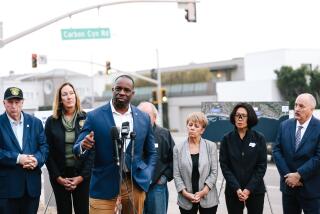Child Safety Advocate Still Driven to Curtail Deaths in Auto Crashes
- Share via
When social worker Stephanie Tombrello in 1970 sought a safe infant car seat for her newborn daughter, the only way she could find one was with help from an auto dealership.
The dearth of safety seats, which then were not required by law, shocked Tombrello. She knew that a dramatic number of traffic fatalities involved children. How many could have been saved, she wondered, if they had been buckled up?
Tombrello decided to dedicate herself to the issue of safety for child passengers. In 1980, she helped found SafetyBeltSafe USA, an Inglewood-based national nonprofit organization that played a key role in pressuring California to enact a 1983 law requiring restraints for children in cars.
*
A decade after that success, Tombrello is still at work. She has organized a “spotters” program aimed at alerting police to motorists who are transporting unbuckled children. Information about alleged violations is forwarded to the California Highway Patrol, which sends a warning letter to the owners of the cars in question.
“Of course, we wish that weren’t necessary at all and all the children were buckled up and safe,” Tombrello said.
Statistics compiled by her group, however, indicate otherwise.
Over the past five years in California, 301 children under the age of 4 died in traffic accidents, the group maintains. In 85% of the deaths, the children were not in restraints at all or were improperly buckled. In 1991, three children died after car doors swung open and the unrestrained youngsters fell out and were run over.
“It’s a terrible waste,” Tombrello said. “This is something that’s preventable. If it weren’t preventable, you’d say it was bad luck. But this is like getting your child immunized. You have to immunize your child against polio, diphtheria--and car crashes.”
California child traffic fatality statistics for 1992 are not yet available. Overall, however, the 1992 national highway death rate will be the lowest ever recorded, largely because Americans are buckling up more and drinking less before driving, according to federal transportation officials.
In California, the figures are even better. And, beginning Jan. 1, law enforcement officers will be authorized to stop vehicles on sight for safety belt violations. California law requires that children be buckled up in safety seats until they turn 4 and weigh more than 40 pounds. All drivers and passengers over 4 must use safety belts.
Although adults appear to be strapping themselves into cars more often, children are not, said Tombrello, noting that the number of child fatalities in the past five years has remained fairly constant. Tombrello, a 52-year-old Altadena resident, works in an office plastered with newspaper clippings of accidents, harsh reminders of the hazards of not buckling up.
To help residents comply with the belt law, SafetyBeltSafe sponsors a car seat loan program and operates a telephone help line to answer questions on passenger safety. The group also conducts educational workshops for health care professionals and law enforcement officers.
*
“As far as child passenger restraint systems . . . they’re the leading private sector group,” said Richard Noonan, an assistant chief with the California Highway Patrol in Los Angeles. “You have a lot of public agency involvement, but as far as this group is concerned, they have kept the issue foremost and specifically focused on child passenger restraints.”
Noonan said CHP checkpoints operated in conjunction with the group in shopping centers have been successful in teaching parents how to use car seats.
“Child-passenger safety is a specialization,” Noonan said. “You don’t realize it until you look at the regulations, the federal standards and requirements for installation. . . . These folks have been very active in ensuring that the equipment has been properly installed.”
More to Read
Sign up for Essential California
The most important California stories and recommendations in your inbox every morning.
You may occasionally receive promotional content from the Los Angeles Times.










